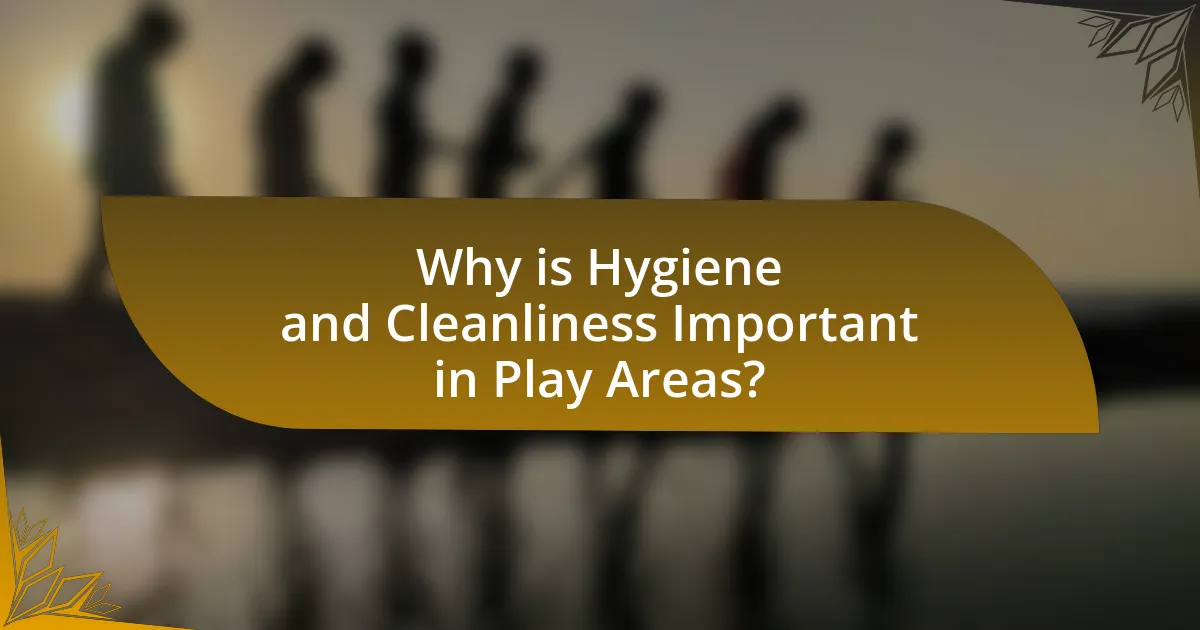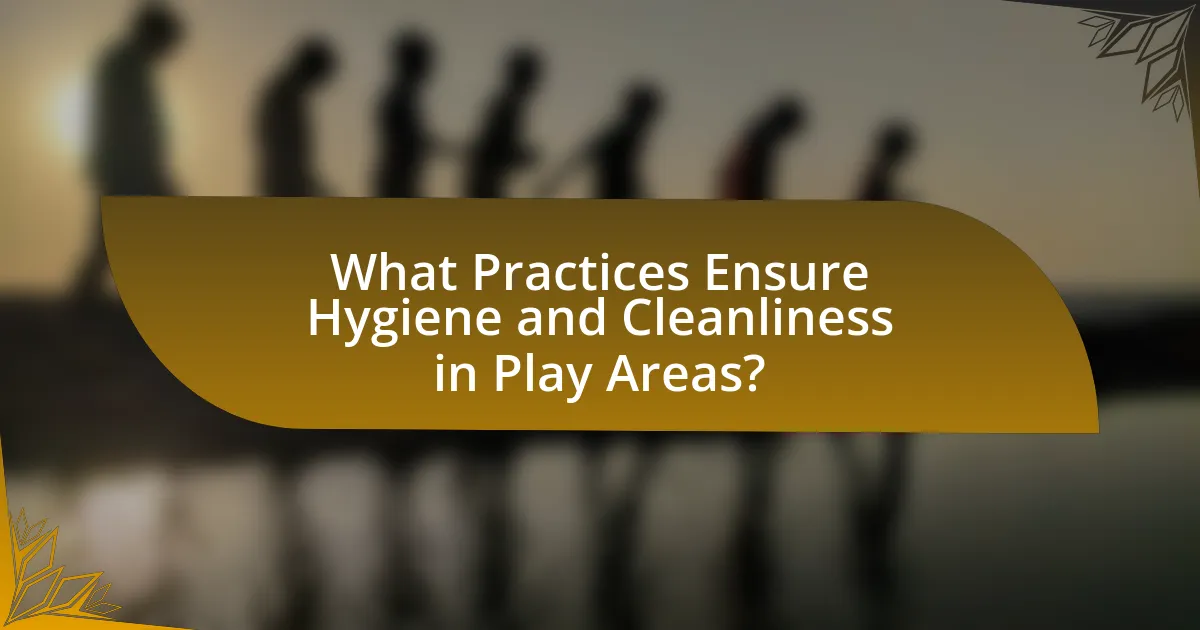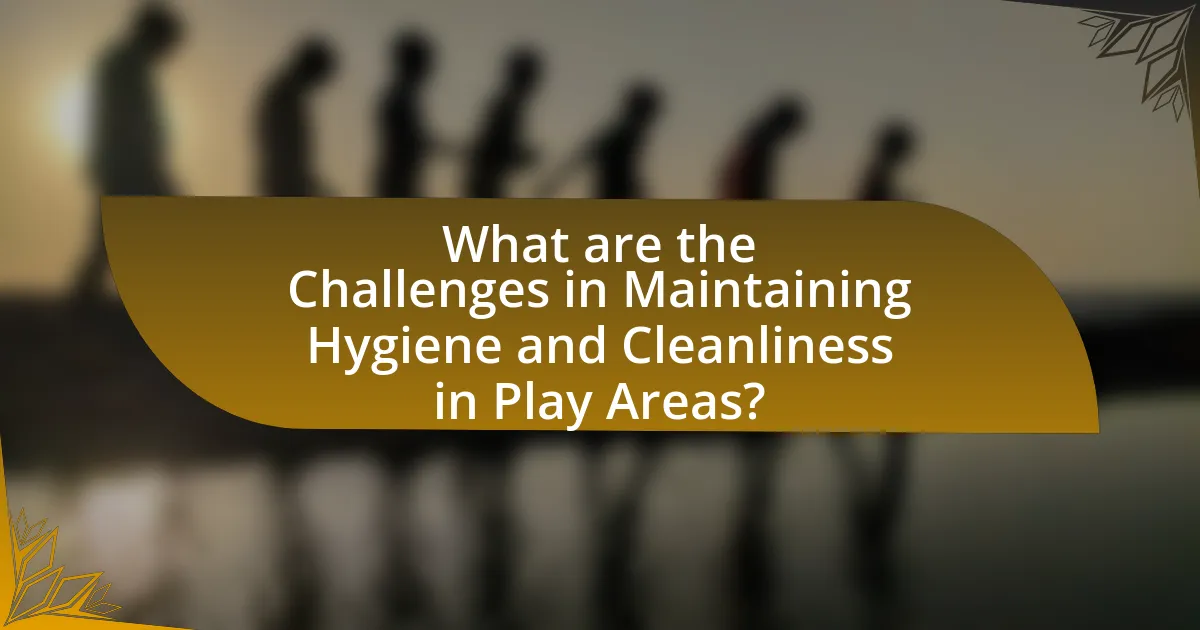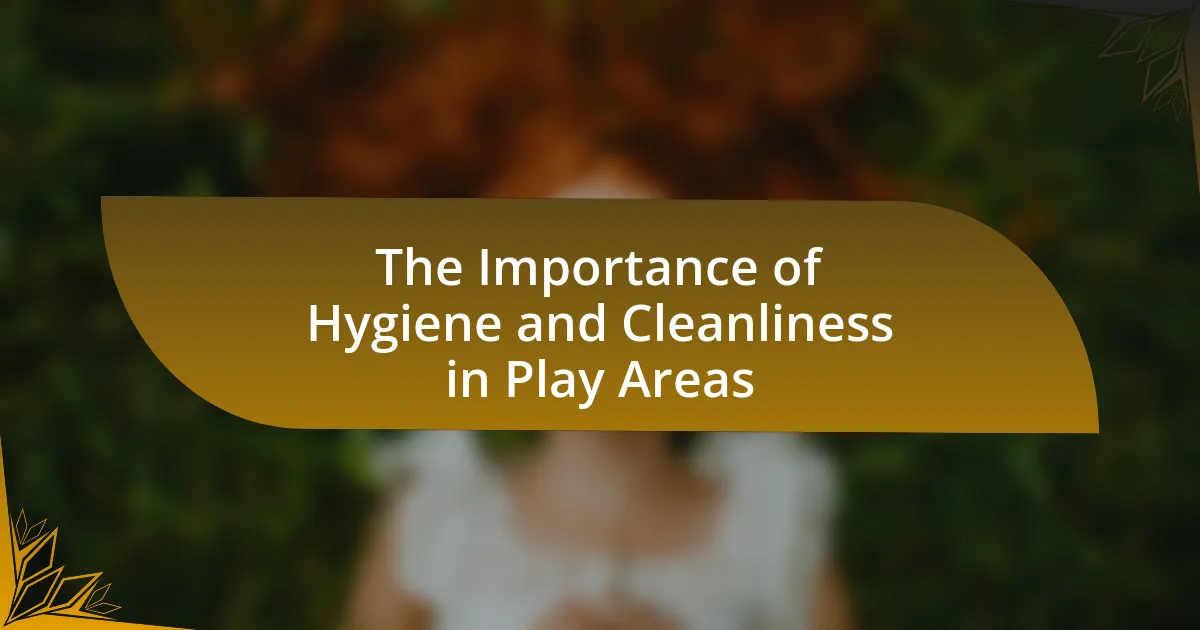Hygiene and cleanliness in play areas are essential for preventing the spread of infections and ensuring children’s safety, particularly given their developing immune systems. The article outlines the health risks associated with unclean play areas, including the transmission of infectious diseases and injuries from hazardous materials. It emphasizes the importance of regular cleaning and sanitization practices, the role of cleanliness in enhancing children’s play experiences, and the societal implications of maintaining hygienic environments. Additionally, the article discusses challenges in maintaining cleanliness, strategies for community involvement, and best practices for ensuring hygiene in play areas.

Why is Hygiene and Cleanliness Important in Play Areas?
Hygiene and cleanliness are crucial in play areas to prevent the spread of infections and ensure children’s safety. Play areas are often frequented by young children who have developing immune systems, making them more susceptible to germs and illnesses. According to the Centers for Disease Control and Prevention (CDC), proper sanitation practices can significantly reduce the transmission of pathogens, thereby lowering the risk of outbreaks of diseases such as norovirus and respiratory infections. Regular cleaning and disinfection of surfaces and equipment in play areas help maintain a healthy environment, promoting overall well-being for children and peace of mind for parents.
What are the health risks associated with unclean play areas?
Unclean play areas pose significant health risks, including the spread of infectious diseases, injuries from hazardous materials, and exposure to harmful bacteria and parasites. These environments can harbor pathogens such as E. coli, Salmonella, and Norovirus, which can lead to gastrointestinal illnesses. A study published in the Journal of Environmental Health found that playground equipment can be contaminated with bacteria, with 50% of samples testing positive for pathogens. Additionally, unclean surfaces may contain sharp objects or toxic substances, increasing the risk of physical injuries and chemical exposure.
How can germs and bacteria spread in play areas?
Germs and bacteria can spread in play areas through direct contact with contaminated surfaces, toys, and equipment. When children play, they often touch various surfaces that may harbor pathogens, such as slides, swings, and play structures. Additionally, respiratory droplets from coughing or sneezing can contaminate nearby areas. Studies indicate that high-touch surfaces in play areas can harbor significant levels of bacteria, with some research showing that up to 70% of playground equipment can be contaminated with harmful microorganisms. Regular cleaning and sanitization of these surfaces are essential to reduce the risk of infection and maintain a healthy environment for children.
What specific illnesses can arise from poor hygiene in play areas?
Poor hygiene in play areas can lead to specific illnesses such as gastroenteritis, respiratory infections, and skin infections. Gastroenteritis, often caused by pathogens like norovirus and rotavirus, can spread through contaminated surfaces and toys. Respiratory infections, including colds and flu, can proliferate in unsanitary environments where children are in close contact. Skin infections, such as impetigo, can also arise from contact with dirty surfaces or shared equipment. These illnesses highlight the critical need for maintaining cleanliness in play areas to protect children’s health.
How does cleanliness impact children’s play experiences?
Cleanliness significantly enhances children’s play experiences by promoting safety and encouraging engagement. When play areas are clean, children are less likely to encounter hazards such as germs, dirt, or sharp objects, which can lead to injuries or illnesses. Research indicates that clean environments reduce the risk of infections, allowing children to play freely and confidently. For instance, a study published in the Journal of Environmental Health found that maintaining cleanliness in playgrounds decreased the incidence of communicable diseases among children by 30%. This reduction in health risks fosters a more enjoyable and uninterrupted play experience, ultimately supporting children’s physical and social development.
What role does a clean environment play in children’s physical health?
A clean environment is crucial for children’s physical health as it reduces the risk of infections and promotes overall well-being. Cleanliness in play areas minimizes exposure to harmful pathogens, allergens, and pollutants, which can lead to respiratory issues, gastrointestinal diseases, and skin infections. Research indicates that children who play in clean environments experience fewer illnesses; for instance, a study published in the Journal of Environmental Health found that regular cleaning of play areas significantly decreased the incidence of communicable diseases among children. Thus, maintaining hygiene in children’s play areas directly supports their physical health by fostering a safer and healthier play environment.
How does cleanliness affect children’s psychological well-being?
Cleanliness significantly enhances children’s psychological well-being by fostering a sense of safety and security. When children play in clean environments, they experience reduced anxiety and stress, which contributes to improved mood and overall mental health. Research indicates that clean spaces promote positive social interactions and cognitive development, as children are more likely to engage in play and learning activities when they feel comfortable in their surroundings. A study published in the Journal of Environmental Psychology found that children in well-maintained, clean play areas exhibited higher levels of creativity and cooperation, highlighting the direct link between cleanliness and psychological benefits.
What are the societal implications of hygiene in play areas?
Hygiene in play areas significantly impacts public health and social behavior. Clean play environments reduce the transmission of infectious diseases among children, which is crucial since children are more susceptible to illnesses. For instance, studies indicate that proper sanitation can decrease the incidence of gastrointestinal infections by up to 50% in communal spaces. Furthermore, maintaining hygiene fosters a sense of community responsibility and encourages parents to allow their children to engage in outdoor activities, promoting social interaction and physical health. The presence of clean play areas can also enhance community pride and increase usage rates, leading to stronger social ties among families.
How do clean play areas influence community health standards?
Clean play areas significantly enhance community health standards by reducing the spread of infectious diseases and promoting physical activity among children. Research indicates that well-maintained play spaces decrease the likelihood of illness transmission, as cleanliness minimizes exposure to harmful pathogens. For instance, a study published in the Journal of Environmental Health found that regular cleaning and sanitization of playground equipment can lower the incidence of gastrointestinal and respiratory infections in children. Additionally, clean play areas encourage outdoor play, which is linked to improved physical health outcomes, such as lower obesity rates and better cardiovascular fitness. Thus, the maintenance of hygiene in play areas directly correlates with enhanced community health standards.
What responsibilities do parents and caregivers have regarding play area cleanliness?
Parents and caregivers are responsible for ensuring the cleanliness of play areas by supervising children, cleaning up after play, and reporting any hazards. Supervision helps prevent littering and encourages children to respect the space. Cleaning up after play, such as picking up toys and disposing of trash, maintains a safe environment. Reporting hazards, like broken equipment or spills, ensures timely maintenance and safety for all users. These actions contribute to a hygienic play area, reducing the risk of illness and injury among children.

What Practices Ensure Hygiene and Cleanliness in Play Areas?
Regular cleaning and sanitization of play areas ensure hygiene and cleanliness. This includes daily disinfection of surfaces, equipment, and toys using EPA-approved disinfectants to eliminate germs and bacteria. Additionally, implementing a routine inspection schedule helps identify and address any maintenance issues that could compromise cleanliness. Research indicates that frequent cleaning reduces the risk of illness among children, as studies show that contaminated surfaces can harbor pathogens for extended periods. Furthermore, encouraging handwashing before and after playtime reinforces personal hygiene, significantly decreasing the spread of infections.
What cleaning protocols should be implemented in play areas?
Cleaning protocols in play areas should include regular disinfection of high-touch surfaces, thorough cleaning of equipment, and routine inspections for cleanliness. High-touch surfaces such as handrails, benches, and play structures should be disinfected multiple times a day, especially during peak usage times, to reduce the spread of germs. Equipment should be cleaned with appropriate cleaning agents that are safe for children and effective against pathogens. Additionally, routine inspections should ensure that the play area remains free of debris and hazards, maintaining a safe environment for children. Implementing these protocols is essential for preventing illness and ensuring a hygienic play space.
How often should play areas be cleaned and sanitized?
Play areas should be cleaned and sanitized daily to ensure a safe environment for children. Regular cleaning helps to remove dirt, debris, and germs that can accumulate from frequent use. According to the Centers for Disease Control and Prevention (CDC), high-touch surfaces in play areas should be disinfected at least once a day, especially during outbreaks of infectious diseases. This practice minimizes the risk of illness and promotes overall hygiene in communal spaces.
What cleaning products are safe and effective for use in play areas?
Safe and effective cleaning products for use in play areas include hydrogen peroxide, vinegar, and mild dish soap. Hydrogen peroxide is a non-toxic disinfectant that effectively kills bacteria and viruses without leaving harmful residues. Vinegar, a natural antibacterial agent, can clean surfaces and eliminate odors. Mild dish soap is safe for cleaning toys and surfaces, effectively removing dirt and grime without harsh chemicals. These products are recommended by health organizations for maintaining hygiene in environments frequented by children, ensuring a safe play area.
How can play area design contribute to better hygiene?
Play area design can contribute to better hygiene by incorporating materials and layouts that facilitate easy cleaning and reduce the accumulation of dirt and germs. For instance, using non-porous surfaces such as rubber or plastic allows for quick sanitation, while designing play areas with fewer crevices minimizes hiding spots for bacteria. Research indicates that well-maintained play areas with appropriate drainage systems can significantly lower the risk of contamination from standing water, which can harbor pathogens. Additionally, integrating handwashing stations within or near play areas encourages children to practice hygiene, further enhancing overall cleanliness.
What materials are best for minimizing dirt and germs in play areas?
Non-porous materials such as rubber, plastic, and metal are best for minimizing dirt and germs in play areas. These materials do not absorb moisture, which helps prevent the growth of bacteria and mold. For instance, rubber flooring is often used in playgrounds because it is easy to clean and resistant to stains, while plastic surfaces can be wiped down effectively to remove contaminants. Studies have shown that non-porous surfaces can reduce the presence of harmful microorganisms compared to porous materials like wood or fabric, which can harbor dirt and germs.
How can layout and accessibility enhance cleanliness in play areas?
The layout and accessibility of play areas can significantly enhance cleanliness by facilitating easier maintenance and encouraging responsible behavior among users. A well-designed layout that includes designated trash receptacles and clear pathways minimizes litter and debris accumulation, making it simpler for maintenance staff to clean the area regularly. Furthermore, accessible features such as ramps and wide pathways ensure that all users can navigate the space without obstruction, reducing the likelihood of spills or accidents that could contribute to unclean conditions. Studies have shown that play areas with thoughtful design elements, such as visibility and accessibility, lead to higher user satisfaction and increased compliance with cleanliness norms, ultimately promoting a healthier environment for children.

What are the Challenges in Maintaining Hygiene and Cleanliness in Play Areas?
Maintaining hygiene and cleanliness in play areas faces several challenges, including high foot traffic, diverse user demographics, and environmental factors. High foot traffic leads to increased dirt, germs, and waste accumulation, making regular cleaning essential yet difficult to manage effectively. Diverse user demographics, including children of varying ages and abilities, contribute to different hygiene needs and behaviors, complicating the implementation of consistent cleaning protocols. Environmental factors, such as weather conditions and outdoor elements, further exacerbate cleanliness issues, as rain or wind can introduce additional debris and contaminants. These challenges necessitate a structured approach to hygiene management, including frequent inspections and the use of appropriate cleaning materials to ensure a safe play environment.
What common obstacles do facilities face in keeping play areas clean?
Facilities commonly face challenges such as high foot traffic, weather conditions, and inadequate cleaning resources in maintaining clean play areas. High foot traffic leads to increased dirt and debris accumulation, making regular cleaning essential yet difficult. Weather conditions, including rain and wind, can introduce additional contaminants, complicating cleanliness efforts. Furthermore, limited cleaning resources, such as insufficient staff or inadequate cleaning supplies, hinder effective maintenance. These obstacles collectively impact the overall hygiene and cleanliness of play areas, which is crucial for ensuring a safe environment for children.
How does high foot traffic affect cleanliness in play areas?
High foot traffic significantly decreases cleanliness in play areas. Increased foot traffic leads to a higher accumulation of dirt, debris, and germs, as more individuals interact with the space. Studies indicate that play areas with heavy usage can harbor up to 50% more bacteria compared to those with lower traffic, highlighting the direct correlation between foot traffic and cleanliness levels. Regular cleaning and maintenance become essential in high-traffic areas to mitigate health risks and maintain a safe environment for children.
What role do weather conditions play in maintaining hygiene outdoors?
Weather conditions significantly influence the maintenance of hygiene outdoors by affecting the growth of pathogens and the effectiveness of cleaning efforts. For instance, high humidity levels can promote the proliferation of mold and bacteria, while dry conditions can lead to dust accumulation, both of which can compromise hygiene. Additionally, rainfall can wash away contaminants, but it can also create muddy conditions that harbor germs. Studies indicate that outdoor environments with adequate sunlight and airflow can reduce microbial presence, as UV radiation has been shown to have disinfecting properties. Therefore, understanding and adapting to weather conditions is crucial for effective outdoor hygiene management.
How can communities overcome these challenges?
Communities can overcome challenges related to hygiene and cleanliness in play areas by implementing regular maintenance schedules and engaging local volunteers for cleanup efforts. Establishing a routine for cleaning and inspecting play areas ensures that facilities remain safe and sanitary for children. For instance, cities like San Francisco have successfully utilized community volunteer programs to maintain parks, resulting in improved cleanliness and increased usage rates. Additionally, educating parents and children about the importance of hygiene can foster a culture of responsibility, leading to better care of shared spaces.
What strategies can be implemented to encourage community involvement in cleanliness?
To encourage community involvement in cleanliness, strategies such as organizing regular clean-up events, creating educational campaigns, and establishing community partnerships can be implemented. Regular clean-up events, like neighborhood clean-up days, foster a sense of ownership and responsibility among residents, leading to increased participation in maintaining cleanliness. Educational campaigns can raise awareness about the importance of hygiene and cleanliness, particularly in play areas, by providing information on health risks associated with litter and unsanitary conditions. Additionally, forming partnerships with local businesses and organizations can provide resources and incentives for community members to engage in cleanliness initiatives, such as sponsoring clean-up supplies or offering rewards for participation. These strategies have been shown to enhance community engagement and improve the overall cleanliness of public spaces.
How can technology assist in maintaining hygiene in play areas?
Technology can assist in maintaining hygiene in play areas through the implementation of automated cleaning systems, UV sterilization, and real-time monitoring applications. Automated cleaning systems, such as robotic cleaners, can efficiently sanitize surfaces without human intervention, ensuring consistent cleanliness. UV sterilization technology can eliminate harmful pathogens on play equipment, as studies have shown that UV light can effectively reduce bacteria and viruses by up to 99.9%. Additionally, real-time monitoring applications can track cleanliness levels and alert staff when areas require immediate attention, enhancing overall hygiene management. These technological solutions collectively contribute to a safer and cleaner environment for children in play areas.
What are the best practices for ensuring hygiene and cleanliness in play areas?
The best practices for ensuring hygiene and cleanliness in play areas include regular cleaning and disinfection of surfaces, providing handwashing stations, and implementing a routine inspection schedule. Regular cleaning and disinfection should occur daily, focusing on high-touch surfaces such as play equipment, benches, and restrooms to reduce the spread of germs. Providing handwashing stations encourages children to wash their hands before and after play, significantly lowering the risk of illness. Additionally, routine inspections help identify areas needing attention, ensuring that cleanliness standards are consistently met. These practices are supported by health guidelines from organizations such as the Centers for Disease Control and Prevention, which emphasize the importance of maintaining clean environments to promote health and safety in communal spaces.
